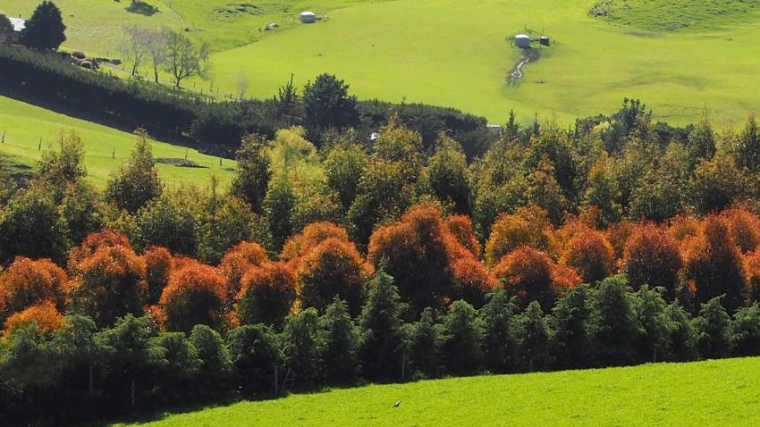
The Government has put forward four options for changes in the Emissions Trading Scheme (ETS). It has acknowledged that significantly more offsetting is happening than is needed, and if there are no changes the ETS will likely collapse due to an oversupply of forestry credits.
It’s good to see concrete options on the table, but we need to consider their implications for farmers. This is a complex area but it is important to find a balance where farmers can register trees in the ETS, but ensure carbon farming doesn’t come at the expense of rural communities and food production.
This is the start of what will likely be a long-term process, so industry will have time to work through some of these issues over the coming months in more detail. It is important to note that even though the Government is looking at options to restrict forestry offsetting, it is also clear it sees offsetting as central to New Zealand’s climate change strategy. Current consultation on this is about managing the scale, pace and type of planting.
So what are the 4 options?
Option 1: Reduce the amount of units the Government ‘auctions’ directly to emitters.
- This option would reduce the supply of units into the market but does not limit the amount of forestry units in the NZ ETS. Emitters can still buy offsets directly from forest owners without needing to go through the Government auction.
- This option would limit the income going to the Government from the sale of units, reducing its ability to support emissions reduction programmes outside of the ETS.
Option 2: Increase the demand for emissions units by allowing international buyers into the market and/or having the Government buy forestry units off the market.
- This option would not restrict forestry offsets in the scheme. Opening New Zealand’s ETS to international players could drive greater levels of forestry offsetting domestically as these international players could simply seek to buy more forestry units.
- However, money from international buyers could be used to support emission reductions work in New Zealand.
Option 3: Establish different prices/values for emissions removals (offsetting) and emissions reduction.
- In this option, emissions reductions would have a higher value than emissions offsetting. This could be achieved in a number of ways, one of which could be by limiting the volume of emissions and emitter can offset (as is the case in California).
- This would create a stronger incentive for emitters to reduce, rather than offset their emissions.
Option 4: Redesign the NZ ETS into two schemes: one for forestry offsets and the other for real emission reductions.
- In this option, there would be separate markets for emissions units as compared to forestry offset units. Emitters wouldn’t be able to use forestry offsets to meet their emissions reduction requirements.
- The price for forestry offsets would likely be determined by the Government which would lead to more control over the pace, scale, and type of planting. For example, there could be a greater price paid for offsets coming from native forests than pine forests.
- This is how the majority of other Emissions Trading Schemes in the world work. This option was favoured by officials in the consultation document overall as the best way to meet the stated objectives.
Recognition of on-farm sequestration
The Government is also seeking feedback on expanding the ETS to recognise a greater range of (mainly) on-farm sequestration such as pre-1990 forests, riparian strips and wetlands. They are also seeking feedback on rewarding landowners for the multiple environmental benefits of this vegetation. This could be done using a biodiversity credits for example.
Many groups including industry leaders Beef + Lamb have been advocating for this recognition. This is good to see and further detail on how this recognition could occur and what conditions would be placed on it will be welcomed. Note that the recognition could occur in the NZ ETS or via another programme such as a government supported voluntary carbon market.
In most other countries, sequestration programmes place much greater emphasis on incentivising and rewarding native vegetation and the integration of trees within farms, over plantation forestry.
The IPCC also more strongly supports the reward and recognition of native vegetation and integration of trees on farms as outlined in one of their recent reports.
It is unclear exactly what the impact would be for farmers based on the information provided and how quickly the Government would be able to expand the ETS. However, it seems there is an appetite to expand the opportunities for farmers to be recognised for the additional carbon stored on their farms. There is positive signalling from the current Government, but the devil will be in the detail, so we watch on with interest.
Listen to the podcast to hear the full interview.
Angus Kebbell is the Producer at Tailwind Media. You can contact him here.
11 Comments
Good succinct article - thank you.
The problem is one of simple physics/chemistry. We are ADDING carbon which has been locked away underground longer that our species has been evolving. We - and every other life-form present - are optimised for a habitat ex that carbon; weather, temperature, chemistry.
In adding it, we have confused ourselves by our fierce belief in an entirely human-constructed thing we call money. It has not been related to anything since the pretense of a gold-linkage went the way of the dinosaurs circa 1970. Manipulations of money, by money or for money, then, are not guarantees of anything.
So we need to address carbon - a total dig-uppable budget, whether it can really be sequestered, or whether the pretense is just inter-generational fraud. Mature forests do not sequester, and we need to replace what we've razed BEFORE we count forests as sinks.
The bigger problem isn't carbon - it's our rate of energy-consumption, which the carbon is the exhaust of. There is no PlanB beyond fossil energy, and it is not only finite, but half-gone (the best half, energy-return-wise).
So we have to invent a method of farming ex fossil energy, long-term sustainable, and work out who we feed, where. That will be a requirement long after the growth-requiring global financial ponzi (the one which tries to relate to 'money' has collapsed.
The next currency will be energy-related (Soddy, and Scientific American, were right...).
Only option 1 or 2 are worth pursing. Options 3 and 4.
Also, why is the ETS scheme failing? The point of an ETS is to price the externality that is net carbon emissions. That is it. Everything else is nice to haves/distracts from it's core purpose. Frankly I see the downside of option 1, where the government has less money to spend on 'reducing emissions' as a good thing, because they tend to spend it in really poor ways that benefit groups they want to court politically.
More specifically, they often engage in 'investments' that reduce carbon emissions at a much higher price than the current carbon price. This is possibly the stupidest thing you can do. It's like seeing icecreams for sale for $1, and offering to pay $3. The private sector would never do this.
Options 3 and 4 are an unmitigated disaster from an economic or financial perspective. They are both tinpot banana dictatorship moves that would see this country become a pariah internationally. Huge erosion of property rights and investment certainty going forward. Court foreign investment then flip the script once the money is invested. Insane.
If there are too many forests being planted and this is having impacts on local community culture or net agricultural exports, then the solution to the first problem is planning to limit the amount of forestry cover at the territorial authority level, and the answer to the second is fixing investment incentives.
Don't break a system to fix the problems caused by it's interaction with other broken systems. This is what 3 and 4 are proposing.
Fix the other broken systems (planning, investment incentives) dummies!
'The point of an ETS is to price the externality that is net carbon emissions. That is it. Everything else is nice to haves/distracts from it's core purpose'.
You didn't read my comment, then. (there is no question-mark, that was a statement).
The whole point is that you cannot fix physical issues with artificial manipulation; Key and English were 100% wrong there, and still are - as is Shaw.
The only thing that will work - but which folk will never vote for - is rationing of FF, with lowering lid. Wait for the howls - but all else is avoidance, virtue-signalling, duck-shoving and false belief.
If folk will never vote for rationing FF, how do you propose to achieve "the only thing that will work"?
You mix two disparate items - though I get what you're on about.
I don't 'propose t achieve'; I merely point out how it could/should be done.
If we were going to have avoided collapse, we'd have listened to Rachel Carson, William Catton, the Limits to Growth crowd. We didn't - but we should have.
I think the system will keep doinf what the system does, until it hits the wall. These days, I days, I teach survival skills for beyond that time.
But to solve carbon; stop burning it. Too easy, all else is avoidance.
Yes the solution is simple, but what about shopping weekends to Sydney?
I agree, a gradually increasing carbon tax on fossil fuels similar to what he have on cigarettes would lead to their eventual phase out and be much simpler and more effective than the ETS. This would drive low value users of fossil fuels out first (e.g. replacing coal boilers with heat pumps), but keep them available for as long as possible for higher value uses where there isn't a viable alternative yet (e.g. shipping and international flights).
The proceeds could then be fed back to the community through a citizens dividend/UBI.
I am having trouble reconcilling these two statements, coudl you explain further?
article: Option 4, "This is how the majority of other Emissions Trading Schemes in the world work"
comment: Option 4, "would see this country become a pariah internationally."
Option 5 appears to be missing - which is remove forestry from the ETS
It is really nothing but a money go round now and as a carbon sink its a short term measure anyway
As a country we would be better off if we had a scheme that specifically focused on retiring land that should not be in pasture -this would achieve better outcomes all round - carbon sink, land protection, village and riverflat protection etc
And if we want to be really forward thinking some of the govt's existing farming land could be involved with land swaps to ensure desired outcomes achieved - I know this has been done badly in the SI with leasehold land but that doesnt mean it cannot have a positive outcome with better management
While forestry is in, they can pretend to be doing something real, and the average punter doesn't think enough to realise the orders-of-magnitude shortfall/discrepancy.
But without forestry, you're down to the pathetic P/R stuff like Air NZ's Antarctica inferences (Bernays, take a bow). Or other greenwash.
Option 5 should be a stewardship payment to land owners who have retired land to permanent forest, exotic or native (able to be selectively logged), or native restoration, gathered by taxing burners, and pro growth politicians, bankers, developers, economists etc.

We welcome your comments below. If you are not already registered, please register to comment
Remember we welcome robust, respectful and insightful debate. We don't welcome abusive or defamatory comments and will de-register those repeatedly making such comments. Our current comment policy is here.